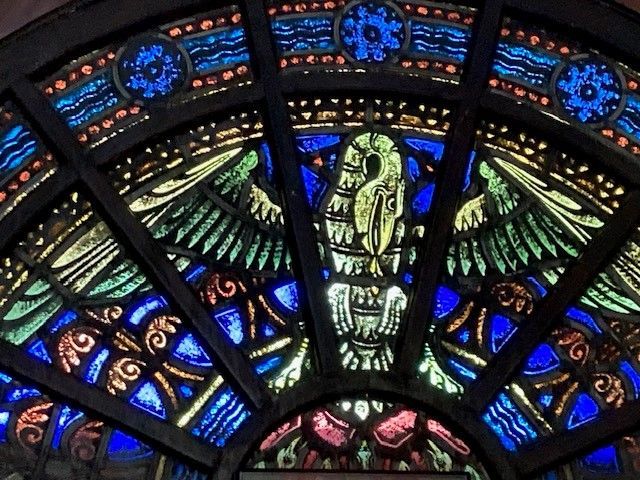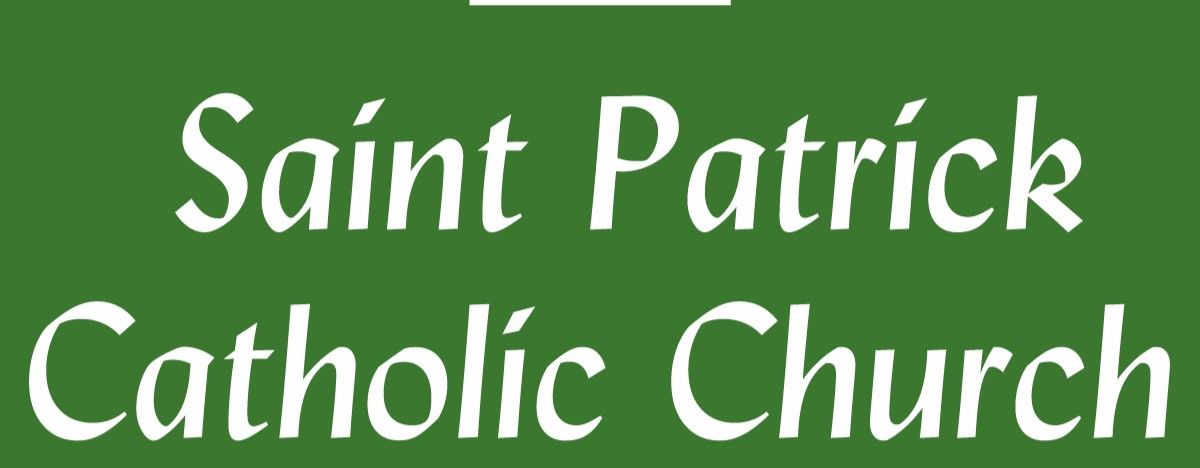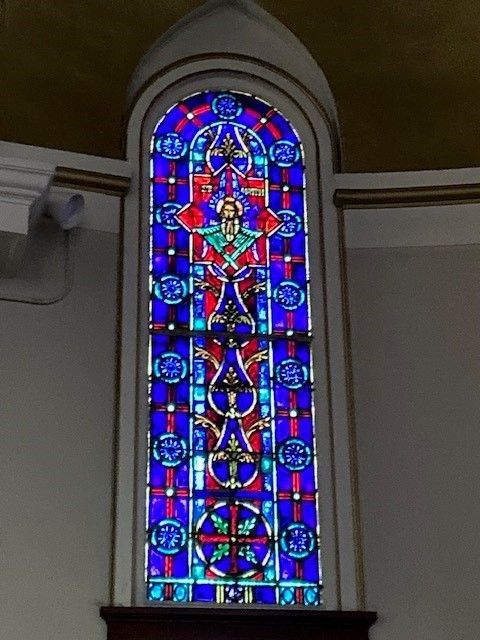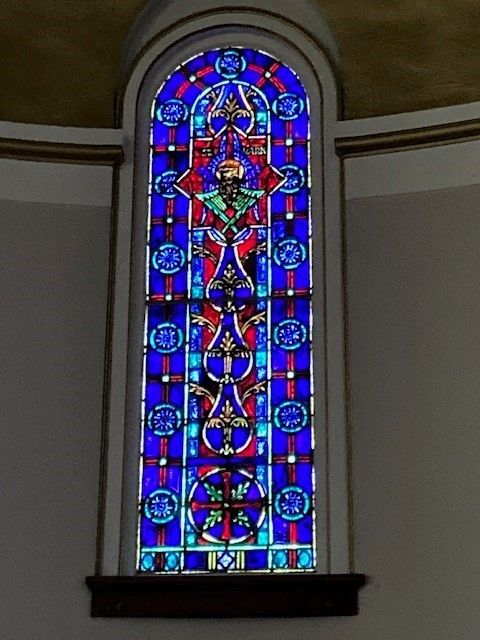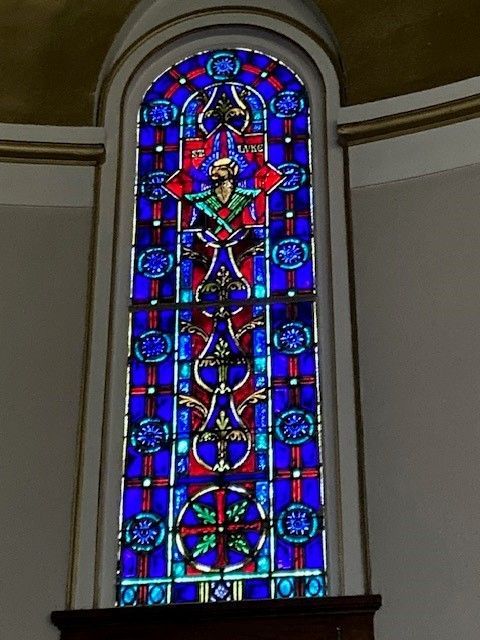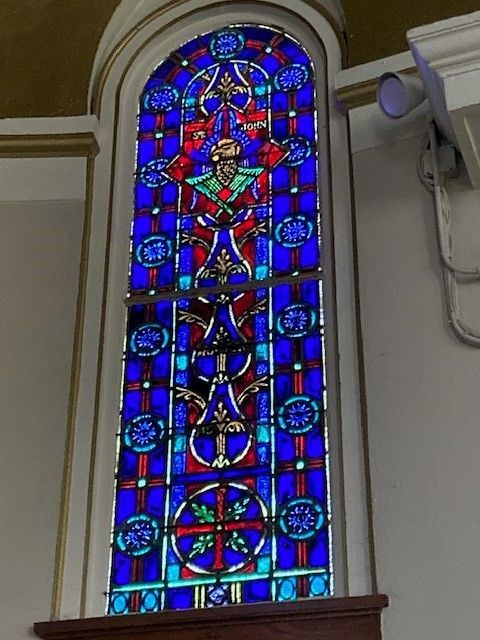Mass Times:
Saturday 5 p.m.
Sunday 7:30, 9:30 11:30 a.m.
Daily Mass Tues-Fri 11:30 a.m.
705 Main St., Cedar Falls, Iowa
(319) 266-3523
facebook.com/saintpatrickcf
Saint Patrick's Stained Glass Windows
Saint Patrick Church is graced with stunning stained-glass windows throughout the sanctuary.
This page provides a guide and additional information to the beautiful artwork that is depicted that helps us to remember the lives of the saints. You can scroll through from top to bottom to see them all, or use the buttons below to navigate to particular groups of windows. Enjoy!
The Twelve Apostles Windows
The Apostles' Windows, six on the west side and six on the east side of the sanctuary, have similar borders, reminiscent of the Art Deco Period. The cost of each was funded through donations by parishioners whose names are noted below each of the photos below. It is thought that they were all installed as one commission in the early 1940s. It is believed that these windows were made by the Milwaukee Art Glass Studio, but that the signature of the artist is obscured by the frames of the vent windows. There are differences in some of the hues in these windows compared to the apse windows, which may indicate they were installed at different times, or may be due to preservation efforts in late 1999.
East side of the church, front to back:
Saint John is frequently shown with a quill and the Scriptures as he is, by tradition, the writer of the fourth Gospel. He was Bishop of Ephesus. At one point he was exiled to the Isle of Patmos. Tradition claims that John was the only disciple to die a natural death at an advance age. Various attempts were made on his life, including a poisoned chalice from which he was miraculously spared. His feast day is December 27th.
Donated by M/M J. W. Leahy
Saint Jude, also known as Thaddeus, is portrayed with a spear. Very little is known about him or where he ministered. Because his name “Judas” is the same as the other “Judas” the Iscariot who betrayed Jesus, Saint Jude is often labeled the “forgotten apostle” and is invoked in prayer as the special patron of those who feel abandoned or forgotten, the patron of “Hopeless cases.” His feast day is October 28th.
Donated by M/M P.A. Dunbar
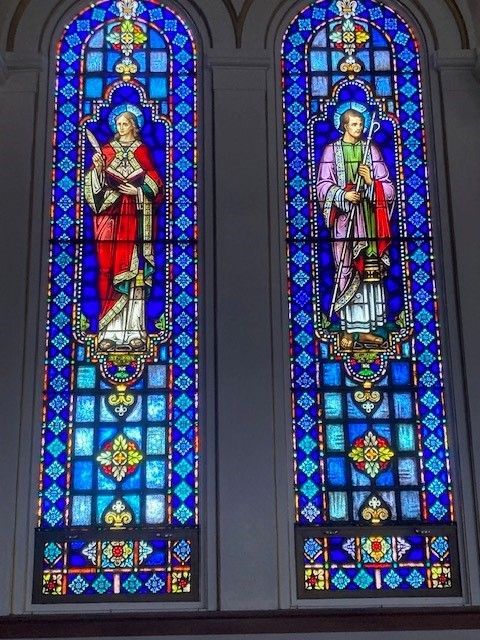
Saint James the Less, sometimes call the “the Just,” worked in or near Jerusalem and was probably the first bishop of that city. An ancient historian claims that he was pushed from the pinnacle of the Temple at the age of 96. Near death, he rose to ask forgiveness for his enemies, who then beat him with a bat and his body was cut apart with a saw (both of these implements are shown in the window). A tower of the Temple can be seen in the background of the window. May 3rd is his feast day.
Donated by the Bernard Smith Family
Saint Matthew is depicted with a scroll as he is the author of a Gospel. He was a tax collector. He spent time preaching in Jerusalem and Ethiopia. Some say he was beheaded, others that he died a natural death. His feast day is May 14th.
Donated by the E.C. Gallagher Family

Saint Matthias, the apostle chosen to replace Judas, worked in Judea and Ethiopia. In the window he is holding the Scriptures as she was a missionary. Because he was beheaded, we see an ax in the window. February 24th is his feast day.
Donated by the F.E. LeValley Family
Saint Simon is holding the scriptures as he was a missionary. He may have served in Palestine and accompanied Saint Jude on hi missions. He was beheaded or carved into pieces with a saw in Persia. Hies feast day is October 28trh.
Donated by Clarence Paul Crangle
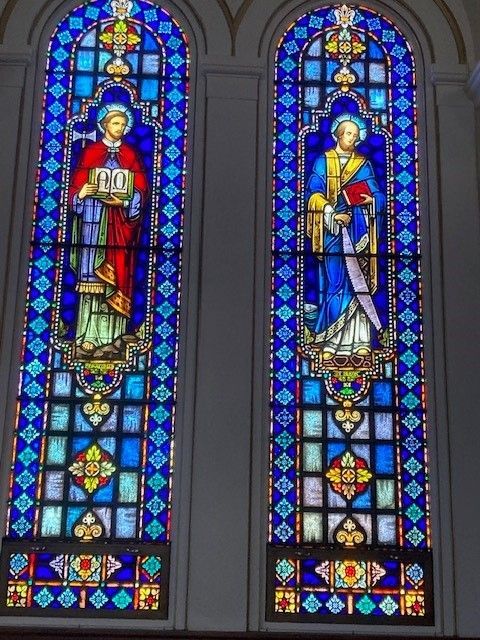
West side of the church, front to back:
Saint Peter is holding keys which represent Jesus saying, “I will give you the keys of the kingdom of heaven” (Mathew 19:19) establishing Peter as “first among the apostles, the one to whom Jesus Himself will hand over the care of the community of believers upon His death and resurrection. He is traditionally dressed in gold. He is Saint Andrew’s brother. He became the leading apostle after Pentecost until the Council of Jerusalem in 50 A.D. He was crucified in Rome under Nero. An ancient historian records that he asked to be hung upside down because he felt unworthy to be crucified in the same manner as his Lord. His feast day is June 29th.
Donated by the A.P. Barker Family
Saint James the Greater is John’s brother. He traditionally preached in Spain after working in Jerusalem. He was beheaded by Herod Agrippa. He is the only apostle whose death is recorded in Scripture (Acts 12:3). A scallop shell symbolizing his occupation as a fisherman prior to his call to discipleship by Jesus and walking staff are seen with James as he is the patron of pilgrims. July 25th is his feast day.
Donated by Mrs. Jennie Tuthill
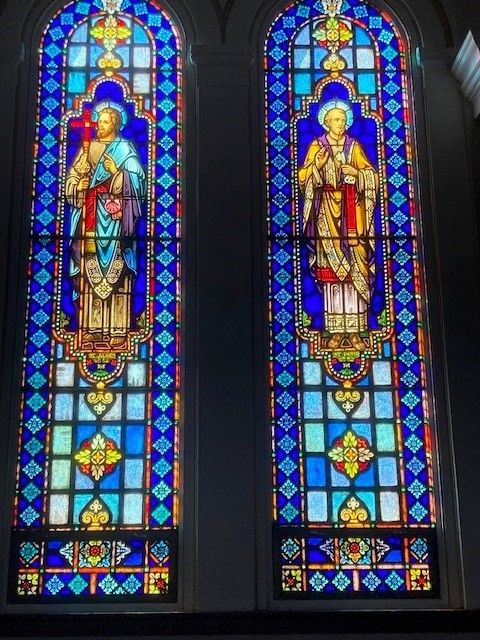
Saint Bartholomew is thought to have preached near the border of India and in Armenia. He is holding a copy of the Scriptures as he was a missionary. The knife seen in the window is the instrument of his martyrdom, as traditionally it is believed that he was flayed alive, crucified, and then beheaded. His feast day is August 24th.
Donated by the Fred Hardy Family
Saint Andrew is Peter’s brother. He is said to have founded the church in Russia. Just as the foundation of the Western Church is rooted in Peter, the Eastern Orthodox Church’s beginning is attributed to Andrew. There is a cross commonly called “Saint Andrew’s Cross,” in the background of this window because tradition holds that he was crucified in Greece. November 30th is his feast day.
Donated by Mrs. C.C. Boysen
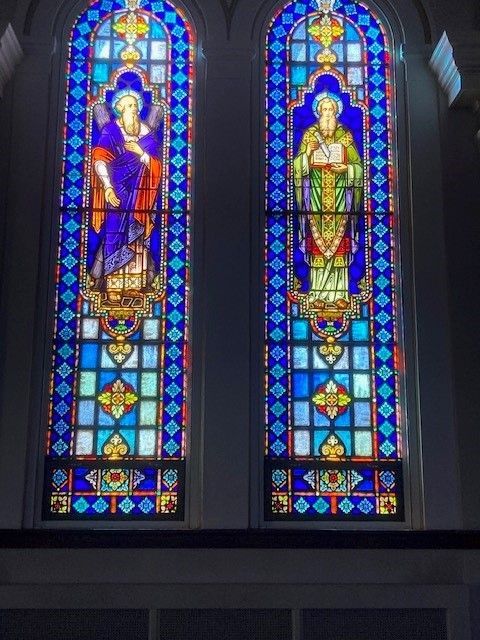
Saint Philip is carrying the Metropolitan, or commonly called “Greek” cross. He may have ministered in Phrygia and Galatia. The loaves of bread seen in the window are reminders of his comment at the feeding of the multitude where Phillip, along with Andrew, brings a young boy to Jesus who has five barley loaves and a couple of dried fish (John 6:7). His feast day is May 3rd.
Donated by The Martin Dolan Family
Saint Thomas was an evangelist in Persia and India. It is reported that he built a church in India with his own hands. He died when he was shot by arrows, stoned, speared, and left to die. Arrows are visible in the windows. July 3rd is his feast day.
Donated by Mrs. Catherine Horan
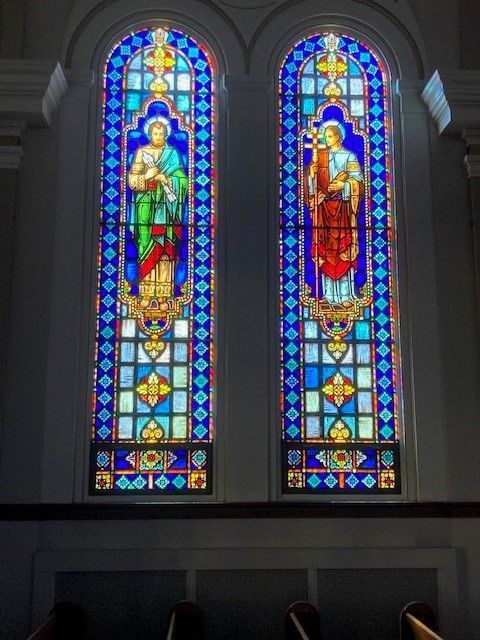
The Altar Windows (Apse)
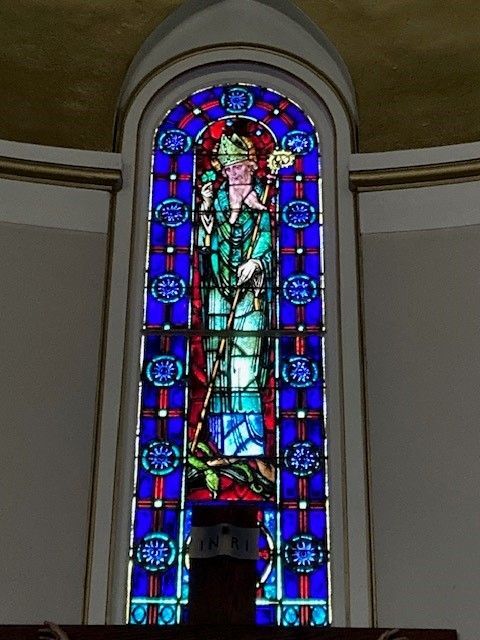
The windows in the apse (the dome behind the altar) depict our patron, St. Patrick, in the center, with the four evangelists -- Matthew, Mark, Luke and John -- to the left and right of the St. Patrick window. The four evangelists are shown as winged creatures that praise and give homage to God (Rev. Chapter 4 and Ezek. Chapter 1)
The evangelist windows are shown in the photos below.
From left to right facing the altar, the first window is Matthew, depicted as a man because he often refers to the Son of Man, Jesus, in his gospel.
In the second window, Mark is depicted as a lion, the king of beasts whose voice is heard everywhere to overcome evil; he is the voice of prophecy.
The middle or third window shows St. Patrick, garbed in bishop's attire with a staff. He is holding a shamrock, which he used to teach about the Holy Trinity. He is standing on a snake, the symbol of evil and sin.
In the fourth window, Luke is seen as an ox, the beast of burden. His gospel is full of compassion and healing stories. He was a physician, and tells us that Jesus bears the burden of our sins and that He heals us.
John, in the fifth window, is shown as an eagle. This is due to his theology of Christ as the one who soars above all, who is divine. Jesus' divinity shines throughout his gospel.
The Pelican Window (half-circle window over west door)
An ancient pre-Christian legend recounts that if a mother pelican is unable to provide food for her young, she will pierce herself to provide sustenance for them through her blood. The symbol of the pelican nourishing her young in this manner became an adapted tradition of early Christian piety which was equated to the death of Christ in order to nourish and heal humanity. In the liturgical life of the Church, Jesus continues to nourish and heal us through the re-presentation of his once-for-all sacrifice on the cross made present in the Holy Eucharist. This window gives an illustration of this tradition.
